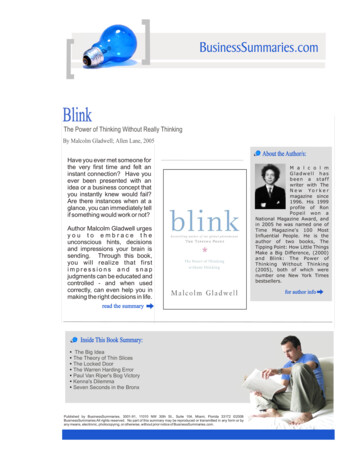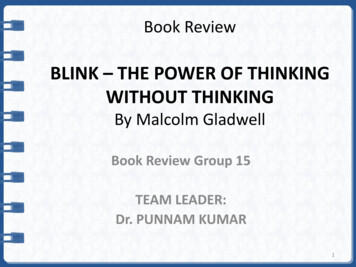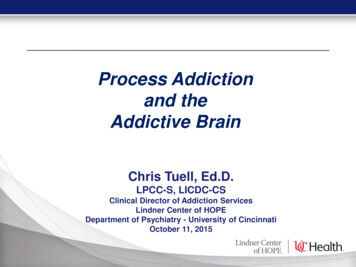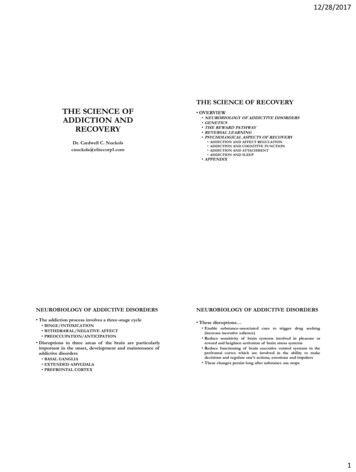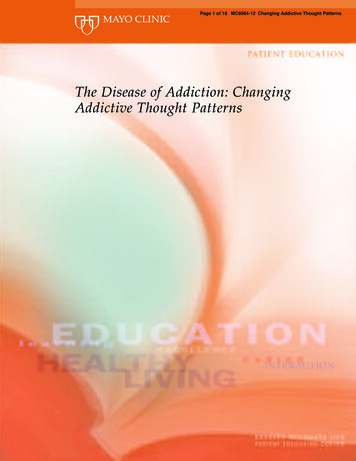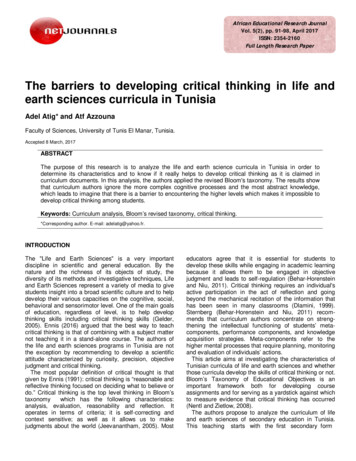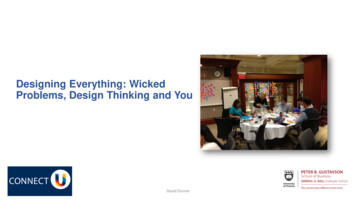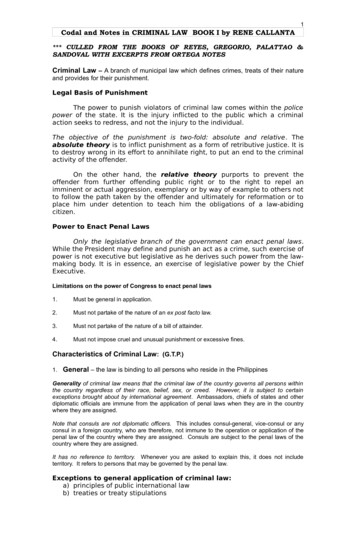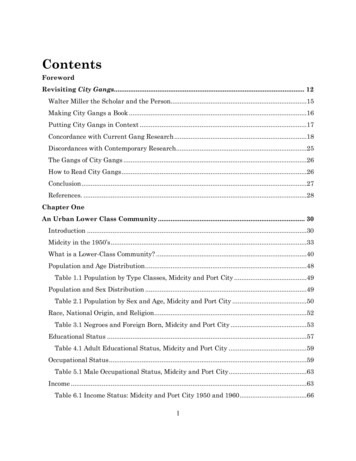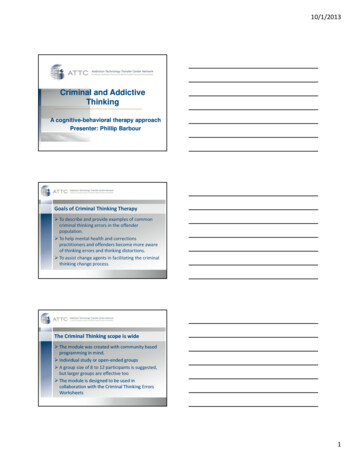
Transcription
10/1/2013Criminal and AddictiveThinkingA cognitivecognitive-behavioral therapy approachPresenter: Phillip BarbourGoals of Criminal Thinking Therapy To describe and provide examples of commoncriminal thinking errors in the offenderpop lationpopulation. To help mental health and correctionspractitioners and offenders become more awareof thinking errors and thinking distortions. To assist change agents in facilitating the criminalthinking change process.The Criminal Thinking scope is wide The module was created with community basedprogramming in mind. Individual study or openopen‐‐ended groups A group size of 8 to 12 participants is suggested,but larger groups are effective too The module is designed to be used incollaboration with the Criminal Thinking ErrorsWorksheets1
10/1/2013Criminal Thinking works in other programs Corrective Thinking, Domestic Violence, AODAand/or Cognitive‐Behavioral focus Adult male or female offenders Batterers and/or drug abusers 7th grade reading level is the intended targetaudienceThe History Utilizes the theory and principles developed byStanton Samenow and Yochelson Investigation of Criminal Behavior at St.St ElizabethsHospital in Washington, D.C. The longest clinical research of offenders in NorthAmerica Three volume publication The Criminal Personality(Lanham, Md.: Roman and Littlefield) that he co‐authored with Dr. Yochelson.Question: What is CriminalThinking?A simple question2
10/1/2013“thinking that says that itsalrightl i ht tto violatei l t othersthor ththeproperty of others”Samuel Yochelson and Stanton SamenowWhy talk about Criminal Thinking? Broaden the scope of intervention Provide information to help your clients To help identify persons where this may be anissue. To aid the criminal thinker in developing,expanding and sustaining a moral conscious.The List: Errors in Thinking1. Closed ChannelThinking2. Victim Stance3. Views Self As A GoodPerson4. Lack Of Effort5. Fear Of Fear6. Lack Of Interest InResponsiblePerformance7. Lack Of TimePerspective8. Power Thrust9. Uniqueness10. Ownership AttitudeCitation: www.criminalthinking.net3
10/1/20131. Closed Channel Thinking Not Receptive Not Self Critical No Disclosure Good at pointing out, giving feedback on faults ofothers Lies by omissionCitation: www.criminalthinking.net2. Victim Stance Views self as victim (the criminal will even blamesocial conditions “I live in the ghetto, what doyouo expect”)e pect”) Blames others (“the cops just keep messing withme”)Citation: www.criminalthinking.net3. Views Self As A Good Person Focuses only on his/her positive attributes Fails to acknowledge his/her destructivebehavior Builds self up at others expenseCitation: www.criminalthinking.net4
10/1/20134. Lack Of Effort / Selective Effort Unwilling to do anything he/she finds boring ordisagreeable "I can't" meaning "I won't“ Doing only the minimum to get byCitation: www.criminalthinking.net5. Lack Of Interest In ResponsiblePerformance Responsible living viewed as unexciting andunsatisfying No sense of obligation Will respond only if he/she nets an immediatepayoff6. Lack Of Time Perspective Does not use past as a learning tool Expects others to act immediately onhis/her/demands/ / Decisions on assumptions, not facts5
10/1/20137. Fear Of Fear Irrational fears (many) but refuses to admit them Fundamental fear of injury or death Profound fear of put down When held accountable experiences "zero state“feels worthless8. Power Thrust Compelling need to be in control of everysituation Uses manipulation and deceit Refuses to be dependant unless he/she can takeadvantage of the situation9. Uniqueness Different and better than others Expects of others that which he/she fails to meet Super‐Optimisim ‐ cuts fear of failure Quits at the first sign of failure6
10/1/201310. Ownership Attitude Perceives all things, people, objects to possess No concept of ownership, rights of others Sex for power and control ‐ not intimacy Use drugs/money as a means of controllingpeopleHow do yyou know?What are some tactics used by thecriminal thinker?Criminal Thinking Tactics1.2.33.4.5.6.7.8.9.Continuously point out staff inadequaciesBuilding self up by putting others downTelling others what they want to hearLying, distorting the truthVaguenessDiverts attentionPutting others on the defensiveTotal inattentionAccusing others of misunderstanding7
10/1/2013Criminal Thinking Tactics continued10.Attempting to confuse others11.Minimizes the situation12.Agrees without meaning it13.Silence14.Selective attention15.Make a big scene about minor issues16.Putting off doing something by saying I forgot17.Claiming that they have changed because they didsomething right, once!Factor’s of people’s past that contribute tocriminal conduct A history of early involvement in deviant orantisocial and criminal conduct; Having grown up in a disruptive,disruptive abusive andneglectful family where there was lack ofparental attention and supervision; Failure in school, work and leisure time; AOD disorders at an early ageRisk factors contributing to criminal conduct Criminogenic need: Dynamic risk factors orattributes of offenders that, when changed,infl ence the probabilitinfluenceprobability of recidivismrecidi ism8
10/1/2013Do criminals think differently than normalpeople? Researchers believe thought patters aremore important than biology orenvironment in determining who becomes acriminal. Some major characteristics include:– master manipulators– compulsive liars– people not in control of their own behavior.Thinking errors or thinking distortions A cognitive distortion is a way ofthinking that is automatic to the pointthat we continue to engage in theerrors of thinking even though ourexperiences and the facts do notsupport the thinking errors. The mental process required by thecriminal to live his/her kind of life.The Criminogenic Need PrincipleMost offenders have many needs. However, certainneeds are directly linked to crime. Criminogenicneeds constituteconstit te ddynamicnamic risk factors orattributes of offenders that, when changed,influence the probability of recidivism.9
10/1/2013Criminogenic Needs: Self‐oriented communication patternsNeed for family closeness and communicationNeed for primary social unit structures such as familyInvolvement in antisocial and deviant behaviorsNeed to manipulate and to control othersReceive rewards through criminal conductParticipate in environments of high‐risk for criminalconductCriminogenic Needs: continued Blame others for own action and behaviors Impaired moral reasoning; hold self‐serving/antisocialmoral codes Overall impaired social and interpersonal skills Overt acting out of feelings of anger and resentment Thinking in a “black and white” concrete manner Need to use substances to support criminal andantisocial conductQuestion: Who are they reallyhurting?Injuries Unseen10
10/1/2013Injury worksheetSelf & VictimFamiliesNeighborsCommunityQuality of Life“Ripple Effect”How do yyou fix this?Related Self-correctionsCriminal Thinking Scales Entitlement Justification Personal Irresponsibility Power Orientation Cold Heartedness Criminal RationalizationKnight, K., Simpson, D. D., Garner, B. R., Flynn, P. M., & Morey, J. T. (in press).The TCU Criminal Thinking Scales11
10/1/2013Steps to undoing Criminal Thinking Learning other‐directed communication patterns Develop ties with family or family‐likerelationships Develop positive social unit and family structures Replace antisocial with pro‐social behaviors Develop self‐control and self‐confidence Shift reward potential to non‐criminal conduct Develop skills to avoid or cope with high‐risksettingsSteps to undoing Criminal Thinking Develop responsibility for own behavior and actions Develop pro‐social and more other‐reflective moralcodes. Develop social and coping skills through social skillstraining Learn self‐regulation of angry feelings and otheremotions Develop skills to increase abstract reasoning andthinking Develop recreational, vocational, and interpersonalalternatives to AOD use and criminal conductResources Texas Christian University (TCU) http://www.ibr.tcu.edu Criminall Thinkingh k Scalesl Testing Forms Criminal Thinking Therapy http://www.criminalthinking.net Workbooks Entire curriculum12
criminal thinking errors in the offender pop lationpopulation. To help mental health and corrections practitioners and offenders become more aware of thinking errors and thinking distortions. To assist change agents in facilitating the criminal thinking change proc
